
California is the 6th biggest gold producer in the US. Read in this article about the history of gold mining in California, about its major active gold mines and other facts and figures about gold mining in CA. This is the state, in which the most most famous gold rush happened – starting from 1848.
Contents
- Is there Gold in California?
- Where is Gold in California?
- Why is there so Much Gold in California?
- What is the History of Gold Mining in California?
- How Much Gold Has Been Mined in California?
- What is the Current State of Gold Mining in California?
- What Companies Mine Gold in California?
- Is it Legal to Mine Gold in California?
- Where Can I Pan for Gold in California?
- Is there Gold in Other US States?
Is there Gold in California?
Yes. Goldfields are mainly in the Sierra Nevada Mountains, the Klamath-Trinity Mountains and to a lesser degree in the south.
California is the state where the most famous gold rush took place. Nowadays there are 3 major active gold mines. Gold is also produced at many smaller mines and as a byproduct, especially at sand and gravel mining, at the more than 700 Californian mines. The US Geological Survey lists more than 22,000 mines with gold deposits in California.
Until 1965 California was the largest gold producing state in the US with over 100 million ounces, responsible for nearly 40% of the gold ever produced in the US; see below.
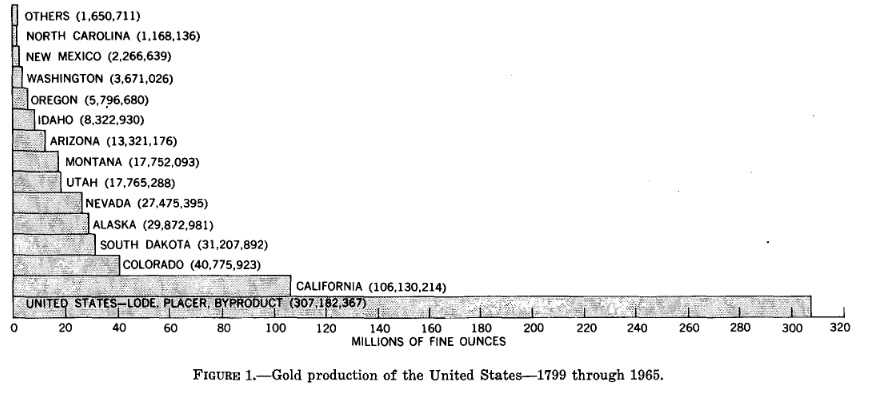
In 2023 California produced gold with a value of $113 million, ranking the state at the sixth position among 11 states reporting production for the third straight year. The top spot goes to Nevada, which produces 74% of the US gold.
Key Takeaways:
| Fact | Explanation |
|---|---|
| Remember | state of the most famous gold rush |
| Gold Deposits | Yes |
| Discovery Year | 1770s |
| Discoverer | not recorded; the first person recorded for its goldfind ist Francisco Lopez; he discovered gold in 1842 north of Los Angeles |
| Gold Mining Industry | Still active |
| Major Gold Locations | Sierra Nevada Goldfields, Klamath-Trinity Mountains, south to a smaller degree |
| Major Active Mines | Mesquite Gold Mine, Castle Mountain Mine, Soledad Mine |
| Mining Companies | Equinox Gold, Western Mesquite Mines and others |
| Panning Locations | Auburn State Rec Area, Butte Rec Area, Columbia State Historic Park, etc. |
Check out the video: Floodwaters drive new gold rush in California:
Where is Gold in California?

Sierra Nevada Region: This region has well over 10,000 gold mines and thousands of active placer claims, making it the top gold region in the state. It has the largest historical gold production totals and the most active modern placer mining districts
Southern California: The gold districts in Southern California are spread throughout a vast area, including desert and mountainous regions known as the transverse and peninsular ranges
State Parks: Several historic gold mining areas are preserved in California state parks, such as Red Rock Canyon State Park, Marshall Gold Discovery site, Empire Mine, and Columbia State Historic Park
Kern River: The Kern River is a prime public gold-mining location in California, attracting experts and enthusiasts in search of gold nuggets
Sources: westernminingindustry, California Department of Parks and Recreation
Why is there so Much Gold in California?
California is renowned for its significant gold deposits, a legacy stemming from the famous California Gold Rush of the mid-19th century. The reasons for the abundance of gold in California are grounded in its geological history.
Here are the key factors:
Tectonic Plate Movements: The Earth’s crust is divided into tectonic plates that constantly move and interact. California is situated on the Pacific Plate, near the boundary with the North American Plate. These tectonic activities have played a crucial role in the formation of mountains and the creation of conditions conducive to gold formation.
Geological Formations: California’s geology is characterized by a diversity of rock types, including volcanic, sedimentary, and metamorphic rocks, which are conducive to gold deposits. The gold in California is often found in quartz veins within these rocks, formed by hydrothermal processes.

Erosion and Weathering: Over millions of years, erosion and weathering have broken down these rocks, causing the gold to be transported and deposited in streams and rivers. This process has led to the formation of placer deposits, where gold particles are concentrated in alluvial soils, particularly in the Sierra Nevada region.
Sierra Nevada Batholith: A significant source of California’s gold is the Sierra Nevada Batholith, a large mass of intrusive igneous rock that was formed during the Jurassic period. As this rock slowly cooled deep underground, gold was deposited in quartz veins.
Historical Gold Rush: The discovery of gold at Sutter’s Mill in 1848 sparked the California Gold Rush, one of the largest mass migrations in American history. This led to extensive mining and prospecting, which revealed the vast extent of gold deposits in the region.
The combination of these geological processes and historical events has resulted in California being one of the most gold-rich states in the USA. The legacy of the Gold Rush continues to influence the state’s culture, economy, and even its nickname, “The Golden State.”
Sources: Yosemite
What is the History of Gold Mining in California?
Gold was disovered in California several times, at different places. At first, none of these discoveries led to a gold rush.
Who Discovered Gold in California?
As early as the 1770s, Mexicans mined small amounts of placer gold from the Colorado river and lode gold from the Cargo Muchacho Mountains. In the 1830s gold was discovered in the Los Angeles area.
More concrete evidence is of gold discoveries in 1842 north of Los Angeles and one year later in San Feliciano County. Both times by Francisco Lopez. This became the first commercial placer mine. The location of other findings, prior to the 1848 gold rush, by “Mission Indians” were not made public.
Check out the video about historical gold mining in the Kern county:
The fateful gold discovery occurred on January 24, 1848 by James Wilson Marshall, while he was constructing a sawmill along the American River northeast of present-day Sacramento. Marshall was a carpenter and a sawmill operator who was working for John Sutter, a Swiss immigrant who owned a large land grant in the Sacramento Valley.
Marshall found a golden nugget in the river while inspecting the tailrace of the sawmill he was building for Sutter. Although Sutter tried to keep the discovery a secret, news of the discovery soon spread, and the California Gold Rush began. (See also the article about the Gold Rush in California).
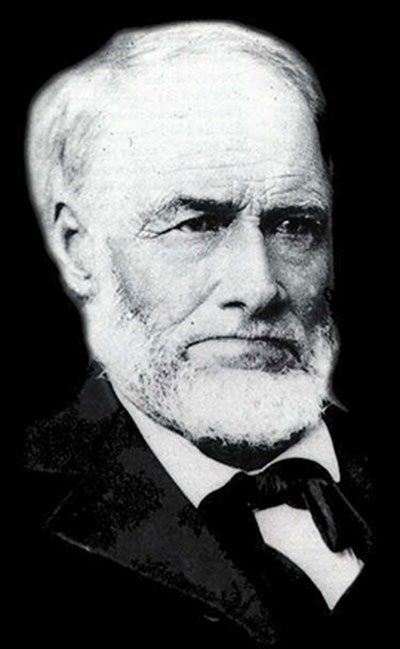
The early days of gold mining in California: The Gold Rush
News of the discovery quickly spread, and 300,000 people from all over the world began to flock to California in search of gold (what is a gold rush?).
These early miners used simple tools like picks, shovels, and pans to extract gold from the rivers and streams of California. In more complex placer mining, prospectors would divert water, to have access to the dried riverbed.
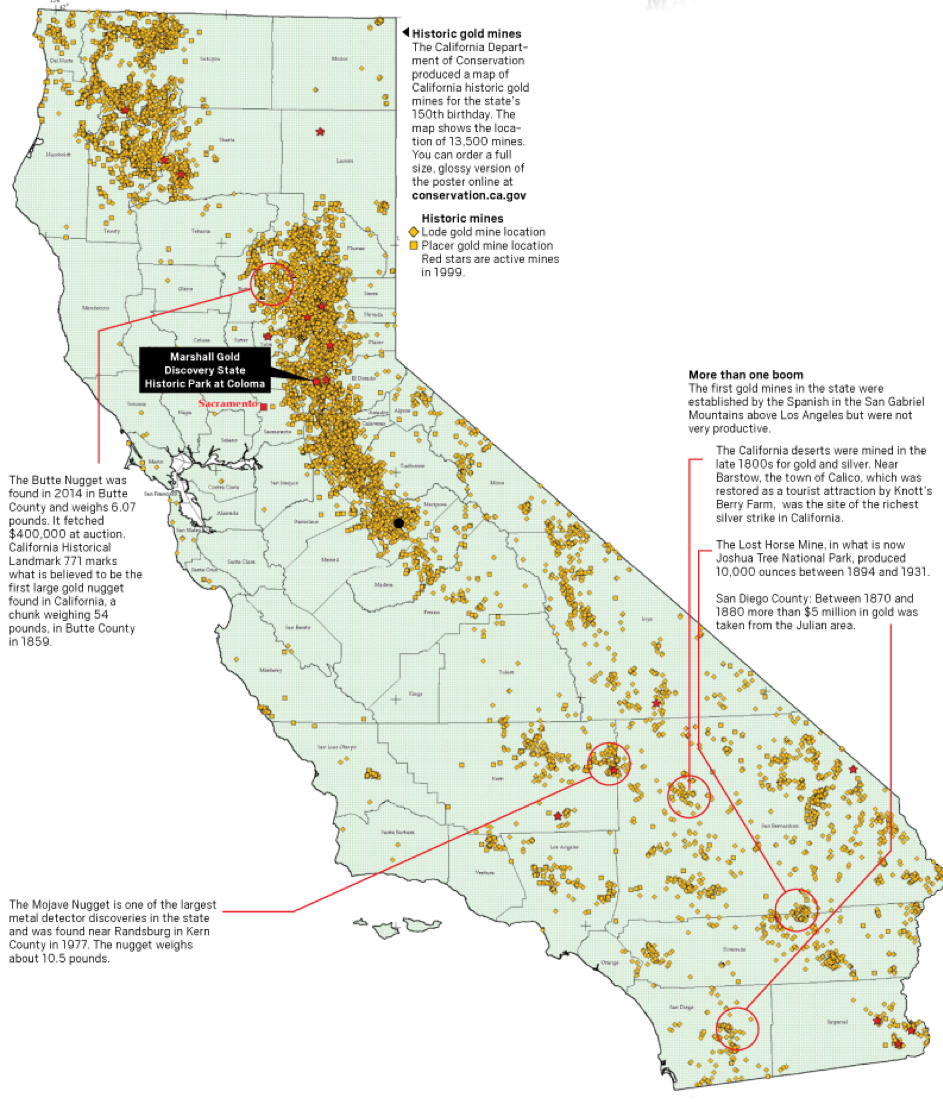
The rise of industrial mining
As the Gold Rush continued, more and more people arrived in California, and the mining techniques became more sophisticated. Hydraulic mining, which involved using high-pressure water jets to wash away hillsides and expose gold deposits, became a popular method of mining in the 1850s.
In this decade, gold-seekers tried to extract gold from rock. This quartz mining involved explosives, the crushing of rocks and copper plates coated with mercury. This led to environmental contamination.
By the late 1800s, the easy-to-find gold deposits in California had been exhausted, and the mining industry began to shift towards industrial mining. Large mining companies like the Homestake Mining Company and the Empire Mine Company began to dominate the industry, using heavy machinery and advanced mining techniques to extract gold from deep underground. During this time, California became the largest gold-producing state in the country, and the mining industry became a major part of the state’s economy. However, the environmental impact of industrial mining was significant, with large areas of land being destroyed and rivers being polluted with toxic chemicals like mercury.
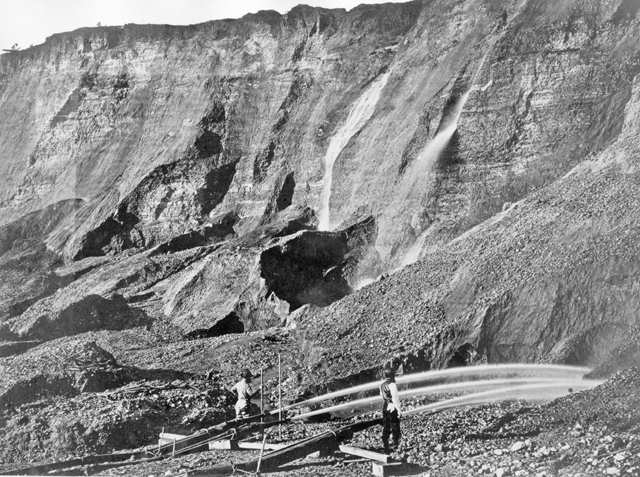
The gold industry in California began to decline in the early 1900s, as the easily accessible gold deposits were depleted and the cost of mining increased. Many of the large mining companies went bankrupt, and the industry shifted towards smaller-scale mining operations.
In 1942 gold mines were shut down to steer the resources to the war economy. This under the War Prodcution Limitation Order L-208. After the war in 1945 the order was lifted, but only some bigger mines commenced operations.
Most of the gold produced in California today comes from small-scale mining operations, and the environmental impact of mining is closely regulated by state and federal agencies.
Sources: California Department of National Parks, Library of Congress, Mining Technology
How Much Gold Has Been Mined in California?
Since 1848, California has produced about 120 million ounces (approx 3.75 million kilogram) of gold, according to the California Department of Conservation.
Gold production in California went up and down considerably, as can be seen in the chart
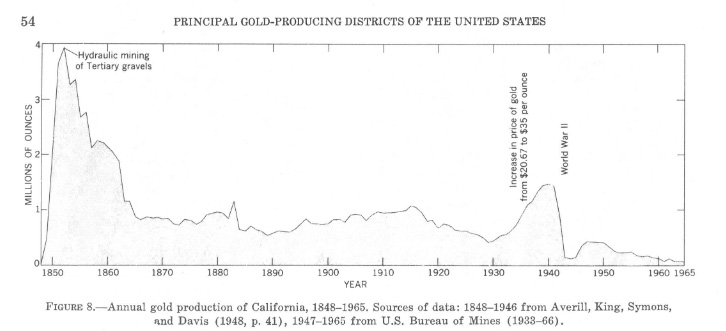
Source: USGS
What is the Current State of Gold Mining in California?
The gold mining industry in California is still active today, although it is much smaller than it was during the Gold Rush era.
California today is a shadow of its former self, with a focus on small-scale operations, recreational activities, and strict adherence to environmental regulations.
According to the United States Geological Survey (USGS), California produced approximately 140,000 troy ounces of gold in 2020.
The USGC lists over 22,000 historical gold sites in California. Until 1965 it was the largest gold producing state in the USA. The majority of mines were in the Sierra Nevada mountain range, followed by the Klamath-Trinity Mountains in northern California.
Nowadays there are around 700 active mines in California producing more than 20 commodities. California takes the fourth place in the production value of non-fuel minerals. (The top spots go to Nevada, Arizona and Texas. Many of these mines list gold as secondary or tertiary commodity (byproduct).
What are the major active gold mines in California?
The US Geological Survey Minerals Yearbook lists in its most recent overview three leading gold producing operations in the state of California, based on publicly available information. All three are open pit, heap leach mines. Two are based between Los Angeles and Las Vegas. The third close to the Mexican border.
Complete list and facts and figures of the 3 major gold mining operations in California:
| US Rank | Operation | County and State | Majority Owner (2024) | Qty 2020 |
Qty 2021 |
|---|---|---|---|---|---|
| 16 | Mesquite | Imperial, CA | Equinox Gold Corp. | 4.390 | 4.280 |
| 29 | Castle Mountain | San Bernardino, CA | Equinox Gold Corp. | 166 | 786 |
| – | Soledad Mountain | Kern, CA | Falco Resources Ltd. (50%), Gauss LLC (50%) | 1.320 (2018) | 1.530 (2019) |
Explanation:
Rank: a comparison of the output of US mines. Therefore, Mesquite, with the highest output of the Californian mines, is ranked number 16 of all US gold mines. Eight of the ten biggest mines are in Nevada. The remaining two are in Alaska and Colorado.
Quantity: in kilogram; there are approx. 32 fine ounces in one kilogram
Based on the table above, the following overview lists the gold operations with more information. Sorted by annual gold output:
- Mesquite Mine: open pit gold mine in Imperial county, owned and operated by Equinox Gold; started operations in 1986, with a production of 6 million ounces and 80,000 – 90,000 ounces of gold in 2023 (exp.). Mine Life until 2023. Currently shift to small pit mining to reduce costs and exploration to extend mine life.
- Castle Mountain Mine: open pit gold mine in San Bernardino county, restarted operations in November 2020 as a small open-pit heap leach mine. 25,000 – 30,000 ounces of gold in 2023 (exp.). Phase 2 expensions expands mine life by 20 years to 2042.
- Soledad Mine: open pit gold and silver mine in Kern county. The operation goes back to the beginning of the 20th century. No production numbers released after 2019, after the aquisition by Thomas M. Clay und family. The last reported production numbers were 1.320kg of gold in 2018 and 1.530kg in 2019.
Read more: visualcapitalist, USGS, USGS, western mining industry
Where are new gold mines explored or developed in California?
- Providence Group of Mines: Providence Gold Mines is the operator of the “Providence Group of Mines.” These properties are located in the “Mother Lode Gold Belt” in Tuolumne County, California. As a general rule, reports have shown that in the Mother Lode Gold Belt, the deeper you mine, the higher the grade of the ore.
- Grass Valley: Grass Valley is home to the Idaho-Maryland Mine, which was once one of the most productive gold mines in California. The mine produced 2.4 million ounces of gold between 1863 and 1956. The mine is currently undergoing a feasibility study to determine if it can be reopened.
Read more about the lifecycle of gold mines: https://www.gold.org/gold-supply/gold-mining-lifecycle
What is the biggest gold mine in California?
The Mesquite mine is the biggest mine in California by annual gold output. In that area, gold was discovered in 1876 by Felizario Parra and extracted by dry washing low grade ore for around 100 years.
Full-scale operations began only in 1986 after the company Gold Fields invested 70 million in exploration and building a modern, industrial open pit mine. At that time 300 people worked at the mine. In 2001 it had to close. Falling gold prices made gold production not economical anymore. 6 years later, the mine reopened and is in production until today.
Equinox God, the mines owner reports the gold reserves at 471,000 ounce and the 2023 production between 80,000 and 90,000 ounce.

What famous mines are currently closed?
- Providence Group of Mines: Providence Gold Mines is the operator of the “Providence Group of Mines.” These properties are located in the “Mother Lode Gold Belt” in Tuolumne County, California. As a general rule, reports have shown that in the Mother Lode Gold Belt, the deeper you mine, the higher the grade of the ore.
- Grass Valley: Grass Valley is home to the Idaho-Maryland Mine, which was once one of the most productive gold mines in California. The mine produced 2.4 million ounces of gold between 1863 and 1956. The mine is currently undergoing a feasibility study to determine if it can be reopened.
- North Bloomfield and Washington districts: The North Bloomfield and Washington districts contained some of the largest hydraulic gold mines in California during the period from the mid-1850s to the early 1880s. The famous Malakoff mine was once the largest hydraulic mining operation in the world. The mines in these districts produced tens of millions of dollars in gold before 1900.
What Companies Mine Gold in California?
There are several companies that mine gold in California. Here are some examples of companies that mine gold in California, for example:

- Equinox Gold is a gold producer with seven mines and four growth projects. In California it operates the Castle Gold Mountain and the Mesquite Gold mines in California. Other mines are operative in Mexico and Brazil.
- K2 Gold is a mining company that is focused on exploring and developing gold projects in California, Nevada and the Yukon Territory (Canada). The Mojave Gold Project is located in southern California.
- MP Materials is a mining company that operates the Mountain Pass mine in California. While the mine primarily produces rare earth elements, it also produces small amounts of gold.
- Roaring Camp Mining Company is a family-owned mining company that offers gold panning tours in the heart of the California Mother Lode Country. The company is located in the Sierra Nevada foothills and has a rich history of gold mining.
- Golden Queen Mining Company is a mining company that operates the Soledad Mountain Mine in Mojave, California. The mine primarily produces gold and silver.
- Vulcan Materials is a mining company that operates several quarries in California, including the Azusa Rock Quarry, which produces gold as a byproduct.
Sources: company websites
Is it Legal to Mine Gold in California?
In California, gold mining is regulated by various laws and regulations. The state allows low-impact gold panning without a permit, but there are restrictions on the use of equipment and the amount of material that can be gathered. For example, the use of vacuum or suction dredging equipment for instream mining is prohibited, and high banking, hydraulic mining, and ground sluicing are not permitted. Additionally, mining claims must be filed with the Bureau of Land Management, and there are restrictions on the use of mechanized equipment on a claim.
Here are some key points to consider:
- Mining Claims: To mine gold legally, you usually need to file a mining claim. There are two types of mining claims: placer claims for minerals like gold that are found in alluvial deposits, and lode claims for vein-type deposits.
- Environmental Regulations: Miners must comply with environmental regulations. In California, this often includes obtaining permits and adhering to specific practices to minimize environmental impact, especially in waterways, due to concerns about water quality and habitat preservation.
- Recreational vs. Commercial Mining: There are different rules for recreational prospecting and commercial mining. Recreational gold panning or sluicing is allowed in certain public lands with fewer restrictions, but commercial operations require more extensive permitting and environmental review.
- Local Ordinances: In addition to state and federal laws, local ordinances can also apply. Some areas in California may have specific regulations or prohibitions on mining activities.
- Cultural and Historical Sites: Areas of cultural or historical significance might be protected, restricting mining activities.
- Public Lands: While some public lands are open to mining, others, like national parks, are off-limits. It’s important to check the status of the land where you intend to mine.
- California Department of Conservation: The California Department of Conservation provides guidance and permits for mining operations, ensuring compliance with state regulations.
Sources: Bureau of Land Management, California Department of Parks and Recreation, seecalifornia
Where Can I Pan for Gold in California?
California is probably the state with the most developed recreational gold panning industry. There are heaps of places and operators for this activity.
Where to find gold in California? Check out the Video:
Here are some examples of places where you can pan for gold in California:
- South Yuba River State Park is located in the Sierra Nevada foothills and is a great spot for panning for gold. The park meanders along a 20-mile stretch of the Yuba River, which is not only a great spot for paddle boarding, swimming, and leaf peeping, but also panning for gold.
- Columbia State Historic Park is located east of the Sierra Nevada and is a great place to pan for gold. It’s also like a Gold Rush version of Colonial Williamsburg, with friendly townspeople dressed in historical garb, a working blacksmith, and an old-fashioned bowling alley.
- Jamestown is home to California Gold Panning, which is run by the Prebalick family, three generations of gold miners. The Prebalicks offer mining classes for school field trips and corporate and team-building parties. The business is located on Wood’s Creek in Jamestown.
- The Swasey Recreation Area is located near Redding and has historic gold-producing areas where one can still pan for gold.
- Butte Recreation Area is located in the Sierra Nevada foothills and is a great spot for panning for gold. It’s also a popular spot for hiking, camping, and fishing.
- Auburn State Recreation Area is located in the Sierra Nevada foothills and is a popular spot for gold panning. It has a rich history of gold mining and is home to the largest gold nugget ever found in California.
- La Porte – Poker Flat – Rich Bar is located in Plumas and Sierra Counties and is a great spot for panning for gold. It’s also a popular spot for hiking, camping, and fishing.
Sources: oc register, national geographic, the travel
Is there Gold in Other US States?
Check out gold production in neighboring states of California: Oregon, Nevada and Arizona.
According to the U.S. Geological Survey (USGC), there are 11 states that mine gold and contribute towards the gold mining statistic: Nevada is responsible for the majority of gold output, around 72%, followed by Alaska (13%). 9 other contribute in sum to the remaining 15% of gold production: Arizona, California, Colorado, Idaho, Michigan, New Mexico, South Carolina, South Dakota, and Utah.
